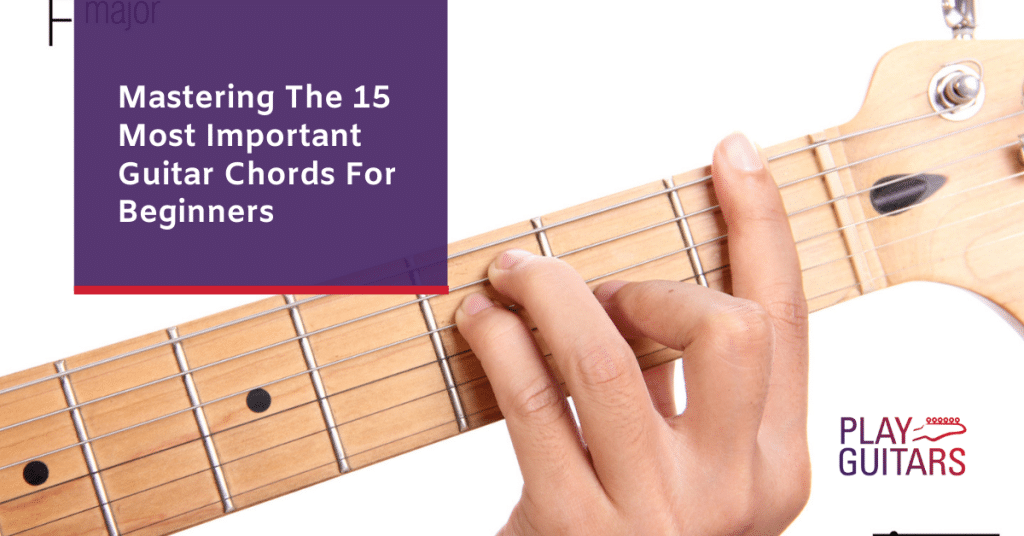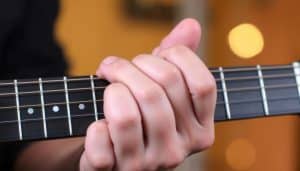Playing the guitar is an incredibly fulfilling and enjoyable hobby that brings endless joy to your life. But what makes it even more exciting is the process of mastering guitar chords. The feeling of sweeping your fingers across those frets and producing melodious sounds is unmatched. Whether you’re a beginner or a seasoned player, the journey of learning and perfecting guitar chords is the best part of playing this magnificent instrument.

The Basics of Guitar Chords
Understanding the anatomy of a chord
When it comes to playing the guitar, chords are an essential element that every guitarist should master. A chord is created by playing multiple notes simultaneously, often consisting of three or more notes. These notes are played on different strings and frets, and when played together, they create a harmonious sound. To understand the anatomy of a chord, it’s important to know the basic components: the root note, the intervals, and the quality of the chord.
The root note is the foundation of the chord and determines its name. For example, in a C major chord, the root note is C. The intervals refer to the distances between the root note and the other notes in the chord. These intervals determine the quality of the chord, whether it’s major, minor, diminished, or augmented. By understanding the anatomy of a chord, you will be able to identify and play a wide variety of chords on the guitar.
Learning the different types of chords
There are various types of chords that you can learn to play on the guitar. The most common chord types include major chords, minor chords, dominant chords, diminished chords, and augmented chords. Each type of chord has a unique sound and characteristics, and they are used in different musical contexts. Major chords have a happy and uplifting sound, while minor chords create a sense of sadness or melancholy. Dominant chords are often used in blues and jazz music, adding tension and resolution to a chord progression. Diminished and augmented chords have a more complex and dissonant sound, which can add a unique flavor to your playing.
By learning and understanding the different types of chords, you will be able to create a wide range of musical textures and convey different emotions through your playing.
Mastering the basic open chords
When first starting out on the guitar, it’s important to learn and master the basic open chords. These chords are played in the first few frets of the guitar neck and involve using open strings, which means that some strings are not fretted or pressed down. The basic open chords include chords such as C major, G major, D major, A major, E major, and F major, among others. These chords are essential because they are widely used in many popular songs and are the building blocks for more advanced chord formations.
To master the basic open chords, it’s important to practice transitioning between them smoothly and accurately. This will help you build finger strength and dexterity, as well as develop a sense of rhythm and timing. With consistent practice, you will be able to play these chords fluently and confidently, allowing you to accompany yourself or others while playing your favorite songs.
Exploring barre chords and power chords
Once you have mastered the basic open chords, it’s time to explore more advanced chord formations, such as barre chords and power chords. Barre chords involve using one finger, usually the index finger, to press down multiple strings across the fretboard, effectively creating a movable chord shape. This allows you to play chords in different keys by simply moving the shape up and down the neck.
Power chords, on the other hand, are minimalistic two-note chords that are commonly used in rock and punk music. They consist of the root note and the fifth interval, creating a powerful and aggressive sound. Power chords are played by fretting the root note on one string and then adding the fifth interval on the string below or above, which gives the chord its distinct sound.
By exploring barre chords and power chords, you will have a wider range of chord options and be able to play in different keys and genres of music. These chord forms also provide opportunities for more dynamic and expressive playing.
Enhancing Your Playing with Chord Progressions
Exploring common chord progressions
Chord progressions are sequences of chords that form the foundation of a song or musical piece. They play a crucial role in determining the overall mood and emotional impact of the music. Learning common chord progressions is essential for any guitarist looking to enhance their playing. Some examples of common chord progressions include the I-IV-V progression, which is widely used in blues and rock music, and the ii-V-I progression, often found in jazz and pop music.
By exploring and practicing common chord progressions, you will develop a deeper understanding of how chords function together and create a sense of harmony and tension. This will enable you to play songs more intuitively and create your own chord progressions.
Understanding the theory behind chord progressions
To fully grasp chord progressions and make the most of them, it’s important to understand the theory behind them. Chord progressions are built upon the relationship between chords within a specific key. This relationship is determined by the harmonized major and minor scales. By understanding how chords are derived from the major and minor scales, you can easily identify and create chord progressions in any key.
Understanding the theory behind chord progressions will also enable you to make informed choices when it comes to chord substitutions and alterations, allowing you to add complexity and variety to your playing.
Using chord progressions to create emotional impact
One of the most powerful aspects of chord progressions is their ability to convey emotions and create a specific mood in music. Each chord has its own emotional quality, and when combined in a progression, they can evoke a wide range of feelings. For example, a major chord progression may sound joyful and uplifting, while a minor chord progression can create a sense of melancholy or introspection.
By experimenting with different chord progressions and paying attention to how they make you feel, you can harness the emotional impact of chords and use them to enhance your playing and connect with your audience on a deeper level.
Developing a sense of rhythm with chord progressions
Chord progressions not only contribute to the harmonic aspect of music but also play a significant role in establishing a strong rhythmic foundation. As a guitarist, it’s important to develop a sense of rhythm and be able to strum or pick the chords in a way that complements the overall rhythm of a song.
Practicing chord progressions with different strumming patterns and rhythmic techniques will help you become more comfortable and confident with your timing and groove. This will allow you to play with other musicians or a metronome more effectively and create a cohesive sound.

Expanding Your Chord Vocabulary
Learning new chord shapes and voicings
Expanding your chord vocabulary involves learning new chord shapes and voicings that you can use to add variety and musicality to your playing. By exploring different chord shapes and voicings, you can find new and interesting ways to play the same chords, creating a fresh sound.
Learning new chord shapes and voicings also allows you to play chords higher up the neck, which can be useful when playing in different keys or when you want to create a different tonal quality. This will open up a whole new world of possibilities and enable you to express yourself more creatively on the guitar.
Discovering alternative fingerings for common chords
In addition to learning new chord shapes, it’s also valuable to discover alternative fingerings for common chords. Different fingerings may offer different voicings or tonal qualities, allowing you to choose the most appropriate option for a specific musical context.
By experimenting with different fingerings for common chords, you will develop finger independence and greater control over your playing. This will add depth and sophistication to your chords, making your guitar playing more expressive and nuanced.
Exploring complex and extended chords
As you progress on the guitar, you may want to delve into more complex and extended chords. These chords add color and complexity to your playing, allowing you to create more intricate and sophisticated harmonies. Complex and extended chords include chords such as seventh chords, ninth chords, eleventh chords, and thirteenth chords.
Exploring complex and extended chords will broaden your chord vocabulary and give you a deeper understanding of harmony. It will also enable you to play more advanced songs and compositions, and give you the tools to create your own unique chord progressions.
Using chord variations to add musicality
Chord variations refer to small alterations or embellishments to the basic chord shapes. These variations can add an extra layer of musicality to your playing and make your chords more interesting and unique.
For example, you can add a sus2 or sus4 note to a chord to create a suspended sound, or you can add a lower bass note to create a richer and fuller sound. These variations can be used sparingly to highlight certain moments in a song or can be employed throughout to add depth and complexity.
By incorporating chord variations into your playing, you can develop your own signature sound and make your guitar playing more captivating and memorable.
Playing Chords in Different Musical Styles
Exploring chord progressions in blues music
Blues music is built upon a specific set of chord progressions that give the genre its distinctive sound. The 12-bar blues progression is one of the most common chord progressions in blues music, consisting of three chords – the I, IV, and V chords. This progression serves as the foundation for countless blues songs and provides a platform for expressive guitar playing.
By exploring blues chord progressions and incorporating blues techniques such as bends and slides, you can capture the essence of the blues and develop your own unique blues guitar style.
Mastering chordal accompaniment in folk music
Folk music often revolves around simple and strummed chord progressions. It emphasizes storytelling and often features acoustic guitar as the main instrument. In folk music, the guitar plays a vital role in providing chordal accompaniment to the singer or other melodic instruments.
Mastering chordal accompaniment in folk music involves learning traditional folk chord progressions and exploring various strumming patterns. Being able to provide a solid rhythm and chordal support to a folk song will allow you to participate in jam sessions and sing-alongs, and showcase your guitar skills in a community of musicians.
Playing chords in jazz and improvisational settings
Jazz music is known for its complex harmonies and improvisational nature. In jazz, chords are often extended and altered to create interesting and colorful harmonies. Playing chords in jazz requires a good understanding of music theory, as well as the ability to comp or accompany other musicians.
By learning jazz chord progressions and studying jazz standards, you can expand your chord vocabulary and develop your improvisational skills. This will allow you to join jazz ensembles, participate in jam sessions, and take your guitar playing to new heights.
Applying chords in rock and pop genres
Rock and pop music rely heavily on guitar chords for their rhythmic and harmonic structure. From classic rock to contemporary pop, chord progressions are the backbone of these genres. Learning to play chords in rock and pop settings involves mastering common chord progressions, experimenting with different strumming patterns and techniques, and developing a strong sense of timing and groove.
By applying chords in rock and pop genres, you can play along to your favorite songs, join cover bands, or even write your own original music. Chords are the foundation of these genres, and mastering them will open up a world of possibilities for your guitar playing.

Building Finger Strength and Dexterity
Practicing chord transitions
One of the biggest challenges for beginner guitarists is transitioning smoothly between chords. This requires coordination and precision in finger placement. Practicing chord transitions is essential for building finger strength and dexterity, as well as improving overall technique.
Start by practicing transitions between two chords, focusing on accuracy and fluidity. Slow practice is key in the beginning, gradually increasing the speed as you become more comfortable. Eventually, you can incorporate more complex chord progressions and challenge yourself with faster transitions.
Consistent practice will train your muscle memory and make chord transitions feel effortless. Not only will this enhance your playing, but it will also allow you to explore more complex songs and progressions.
Developing finger independence
Finger independence is crucial for playing complex chords, intricate melodies, and intricate fingerstyle patterns. As a guitarist, you want each finger to be able to move independently, making it easier to execute various chord shapes and techniques.
To develop finger independence, there are exercises you can incorporate into your practice routine. These exercises can include finger stretching, finger tapping, and finger independence drills that isolate each finger.
Regular practice of these exercises will improve your finger strength and dexterity, allowing you to navigate the fretboard with ease and fluidity.
Building strength through chord exercises
In addition to finger independence, building hand and finger strength is essential for playing chords effectively. This involves not only pressing down the strings but also maintaining consistent pressure and sustaining the sound of each chord.
There are various exercises you can incorporate into your practice routine to build hand and finger strength. These exercises can include finger presses, finger squeezes, and finger push-ups on the guitar strings. Additionally, practicing barre chords and power chords can also help in strengthening your fingers.
Building hand and finger strength will improve your overall playing technique and endurance, making it easier to perform chords and sustain them.
Using fingerstyle techniques to strengthen chords
Fingerstyle techniques are a great way to strengthen chords while adding complexity and richness to your playing. Fingerstyle involves plucking the strings with your fingers rather than using a pick, allowing you to control the dynamics and bring out different voices within a chord.
By incorporating fingerstyle techniques into your playing, such as fingerpicking patterns and thumb slaps, you can develop your finger strength and control. This will allow you to create more nuanced and expressive chordal accompaniment, as well as execute intricate fingerstyle arrangements.
Using fingerstyle techniques not only strengthens your chords but also adds a new dimension to your playing, giving you more options for creative expression.
Unlocking the Secrets of Chord Theory
Understanding the major and minor scales
To fully grasp chord theory, it’s important to understand the major and minor scales, as chords are derived from these scales. The major scale is the most common scale in Western music and serves as the foundation for many chord progressions. It consists of seven notes and follows a specific pattern of intervals.
The minor scale, on the other hand, has a different pattern of intervals and creates a different mood compared to the major scale. Understanding the major and minor scales will allow you to recognize and build chords based on these scales, enabling you to create chord progressions that are harmonically pleasing.
Exploring diatonic chord progressions
Diatonic chord progressions refer to chord progressions that are made up of chords derived from the same key or scale. These progressions create a sense of unity and coherence in music. By exploring diatonic chord progressions, you will gain insight into the relationships between chords within a key and how they can be used to create tension and resolution.
Understanding diatonic chord progressions will enhance your ability to play by ear, analyze songs, and create your own compositions. It will also give you a deeper understanding of harmonic relationships and make learning new songs and progressions much easier.
Learning about chord families and their relationships
Chords can be grouped into families based on their root note and quality. For example, all major chords with different root notes belong to the same chord family. Understanding chord families and their relationships will help you recognize patterns and similarities between chords, making it easier to learn and remember new chords.
By learning about chord families, you will also be able to apply chord substitutions and alterations more effectively, allowing you to add your own unique flavor to chord progressions and compositions.
Applying chord substitutions and alterations
Chord substitutions and alterations are techniques that allow you to add variety and complexity to your chord progressions. They involve replacing or modifying certain chords within a progression to create different harmonic flavors and textures.
For example, you can substitute a major chord with a dominant seventh chord to add tension and create a bluesy sound. You can also add extensions, such as ninths or elevenths, to alter the color of a chord.
By applying chord substitutions and alterations, you can take a simple chord progression and transform it into something unique and interesting. These techniques provide opportunities for creative exploration and allow you to develop your own musical voice.

Expressing Emotions through Chords
Understanding the emotional qualities of different chords
Every chord has its own emotional quality and can evoke a particular mood or feeling. Major chords are often associated with happiness, positivity, and optimism. Minor chords, on the other hand, tend to convey sadness, melancholy, or introspection. Other chords, such as diminished or augmented chords, create tension and unease.
By understanding the emotional qualities of different chords, you can use them to your advantage when creating music or playing a particular song. Being able to identify and harness the emotional impact of chords will add depth and meaning to your playing.
Creating moods with chord voicings
In addition to the emotional qualities of individual chords, the way you voice or arrange chords on the guitar can also contribute to the overall mood of a piece of music. Different chord voicings can create different textures and colors, allowing you to evoke specific moods or emotions.
Experimenting with different chord voicings, inversions, and fingerings can help you create unique and evocative chord progressions. By selecting chord voicings that resonate with the emotional message you want to convey, you can enhance the impact of your playing and connect with your audience on a deeper level.
Using chord progressions to convey a specific feeling
Chord progressions play a crucial role in establishing the emotional context of a song or piece of music. By choosing chord progressions that match the desired feeling, you can create a strong emotional impact.
For example, a simple I-IV-V progression in a major key can convey a sense of joy and celebration, while a minor chord progression with subtle variations can create a somber or reflective mood. By intentionally selecting chord progressions that align with the emotional message of your music, you can effectively communicate and evoke the desired response from your listeners.
Applying dynamics and expression to chord playing
Dynamics and expression are important elements of music that can greatly enhance the emotional impact of chords. By varying the volume, intensity, and articulation of your chord playing, you can bring the music to life and make it more engaging and expressive.
Experiment with playing chords softly and gradually increasing the volume to create a sense of anticipation or build-up. Use accents or emphasized strums to highlight certain beats or notes within a chord progression. Explore different strumming techniques, such as palm muting or percussive hits, to add texture and rhythmic interest.
By incorporating dynamics and expression into your chord playing, you can make your music more dynamic and captivating, allowing you to fully express your emotions through the guitar.
Mastering Chord Transitions and Strumming
Improving chord changes for smoother transitions
Smooth chord transitions are essential for seamless and rhythmically accurate playing. In order to improve your chord changes, it’s important to practice transitioning between chords slowly and deliberately. Start by isolating the problem areas and gradually increasing the speed as you become more comfortable.
Focus on maintaining a relaxed and loose hand position, as tension can hinder smooth transitions. Use visualization techniques to mentally prepare for the next chord shape and visualize the finger placement before making the physical change. This will help train your muscle memory and make chord transitions feel more natural and effortless.
Consistent practice and attention to detail will gradually improve your chord changes and make your playing sound more cohesive and professional.
Developing strumming patterns and rhythmic techniques
Strumming patterns and rhythmic techniques form the backbone of chordal accompaniment. Developing a diverse repertoire of strumming patterns will allow you to add rhythmic complexity and interest to your playing.
Start by mastering basic strumming patterns, such as the down-up-down-up pattern. Practice these patterns with various chord progressions, focusing on consistency and accuracy.
Once you have a solid foundation, you can explore more advanced strumming patterns, such as fingerstyle patterns or percussive strumming techniques. Experiment with accents, syncopation, and dynamic changes to add depth and texture to your playing.
By developing strumming patterns and rhythmic techniques, you can elevate your chord playing and make it more engaging and exciting.
Exploring different dynamics and accents in strumming
Dynamics and accents are important elements of strumming that can greatly enhance the musicality and expression of your chord playing. By varying the volume, intensity, and articulation of your strums, you can bring out different voices within a chord, create rhythmic interest, and highlight important beats or notes.
Experiment with playing certain strums softly to create a delicate or introspective mood, and increase the volume for a more powerful and vibrant sound. Use accents to emphasize certain beats or notes within a strumming pattern, giving them a sense of importance or emphasis.
By exploring different dynamics and accents in your strumming, you can add depth and nuance to your chord playing, making it more dynamic and expressive.
Using muting and palm muting to enhance chord playing
Muting techniques can be used to add percussive elements and control the sustain of chords, giving them a more defined and tight sound. Muting involves lightly touching the strings with your fretting hand or using your strumming hand to dampen the strings.
Palm muting is a technique commonly used in rock and metal music. It involves resting the edge of your strumming hand near the bridge of the guitar to mute the strings partially. This creates a muted, “chunky” sound that is often associated with rhythmic rock and metal playing.
By incorporating muting and palm muting techniques into your chord playing, you can add a touch of percussiveness and control to your sound, making your chords more precise and distinctive.

Playing Lead Guitar with Chords
Learning chord-based solos and riffs
Playing lead guitar with chords involves integrating chord shapes into your soloing and riffing. This allows you to create interesting melodies and harmonies that complement the underlying chord progression.
To get started, learn how to identify and play the chord tones within a specific chord shape. Once you are comfortable with this, incorporate these chord tones into your solos and riffs. Experiment with different scales and techniques to create melodic lines that weave in and out of the underlying chords.
By learning chord-based solos and riffs, you can create a more cohesive and harmonically rich lead guitar style, adding depth and complexity to your playing.
Exploring melodic playing within chord progressions
Melodic playing within chord progressions involves creating melodies that fit harmonically with the underlying chords. This technique allows you to add a melodic layer to your chord playing, making it more interesting and dynamic.
To explore melodic playing within chord progressions, start by identifying the chord tones and their relationship to the underlying chords. Then, experiment with creating melodic lines that connect these chord tones, using techniques such as slides, bends, and vibrato to add expressiveness.
By incorporating melodic playing within chord progressions, you can showcase your ability to create memorable melodies that are influenced by the chords being played, adding a sophisticated touch to your playing.
Using arpeggios to embellish chord progressions
Arpeggios are a powerful tool for embellishing chord progressions and adding melodic interest to your playing. An arpeggio is simply playing the individual notes of a chord in a broken, sequential pattern rather than strumming them all together.
By learning different arpeggio shapes and incorporating them into your chord progressions, you can create fluid and expressive lines that highlight the underlying chord changes. This technique is commonly used in genres such as jazz and classical guitar, but can be applied to any style of music.
By using arpeggios to embellish chord progressions, you can showcase your technical proficiency and add a sophisticated flair to your playing.
Developing improvisational skills with chords
Improvisation is the art of spontaneously creating music on the spot. Developing improvisational skills with chords allows you to freely express yourself and explore different musical ideas in real-time.
To improve your improvisational skills with chords, start by familiarizing yourself with different scales and arpeggios that correspond to the underlying chords. Then, practice playing over different chord progressions or backing tracks, experimenting with different melodies, rhythms, and techniques.
With consistent practice and experimentation, you’ll develop a deeper understanding of how chords and scales interact, allowing you to create captivating and unique improvisations.
The Joy of Playing Chord-Based Songs
Finding satisfaction in playing popular songs
One of the joys of playing guitar is being able to play popular songs and recreate the music you love. Many popular songs are based on simple chord progressions that are accessible to beginner and intermediate guitarists.
By learning the chords to your favorite songs, you can experience the satisfaction of playing along to the music you enjoy. This can be a source of motivation and inspiration, as well as a way to improve your overall guitar skills.
Applying chords to accompany your own singing
The guitar is a versatile instrument that can accompany vocals beautifully. By learning and mastering chords, you can provide the perfect accompaniment to your own singing or that of others. Whether you’re playing acoustic folk tunes or belting out rock anthems, the ability to play chords while singing opens up a world of musical possibilities.
Applying chords to accompany your own singing allows you to express yourself more fully and create a fuller, more engaging musical experience for yourself and your audience.
Creating unique chord arrangements of favorite tunes
Once you have mastered chords and become comfortable with playing popular songs, you can start getting creative and creating your own unique chord arrangements. This involves adding your own personal touch and interpretation to the songs you love.
Experiment with different strumming patterns, chord voicings, and embellishments to make the songs your own. Add dynamics, accents, and variations to add depth and nuance to your arrangements.
Creating unique chord arrangements of favorite tunes allows you to showcase your creativity and musicality, and can be a rewarding and fulfilling aspect of playing guitar.
Sharing your passion for music through chord-based songs
Playing chord-based songs not only brings joy and fulfillment to your own life but also allows you to share your passion for music with others. Whether you’re performing for friends and family, playing in a band, or busking on the street, the ability to play chords on the guitar opens up opportunities for connection and expression.
By sharing your passion for music through chord-based songs, you can inspire and bring joy to others, creating lasting memories and a sense of community through the power of music.
In conclusion, mastering guitar chords is an essential aspect of becoming a proficient guitarist. By understanding the anatomy of a chord, learning different types of chords, and mastering basic open chords, you can lay a solid foundation for your playing. Exploring barre chords, power chords, and other advanced chord formations will further expand your chord vocabulary and open up new possibilities. Chord progressions, chord theory, and expressive techniques allow you to enhance your playing and convey emotions through chords. Building finger strength and dexterity, as well as mastering chord transitions and strumming, will make your playing more fluid and dynamic. Playing lead guitar with chords, creating chord-based solos and riffs, and developing improvisational skills will add depth and complexity to your playing. Finally, playing chord-based songs allows you to find joy in music, express yourself creatively, and share your passion with others. So pick up your guitar, start practicing those chords, and enjoy the journey of mastering guitar chords.






